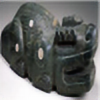HOME | DD
 Pterosaur-Freak — Atlantis Bestiary: Atlantapalone vulcanogenes
Pterosaur-Freak — Atlantis Bestiary: Atlantapalone vulcanogenes

#speculativeevolution #speculativebiology #speculativezoology #atlantisbestiary
Published: 2021-12-05 23:06:10 +0000 UTC; Views: 29980; Favourites: 496; Downloads: 0
Redirect to original
Description
This is my first entry for 's spec bio contest.
Atlantapalone vulcanogenes is a huge softshell turtle (family Trionychidae) from the Palaeocene of Atlantis which is convergent with modern open-water turtles such as Cheloniids and Carettochelys. Like them it has forelimbs modified into flippers and a smooth, streamlined shell. As adults, they inhabit tropical near-shore waters and estuaries around the island continent. They prefer calm water with sandy or muddy bottoms and tend to avoid rocky coasts and strong surf. They are incredible swimmers; the fastest turtles known in earth's history, they can swim at speeds of up to 40 kilometers per hour, outpacing all but the speediest predators. This is important, as their soft shells, while offering better flexibility and maneuverability than those of conventional turtles, do not provide the same level of protection. Like modern Cheloniid sea turtles, they lack the ability to withdraw their heads and limbs into their shells. Since they retain the softshell turtle's ancestral long neck, this gives them a distinctly prehistoric visage despite them being otherwise modern in their anatomy.
Females can grow to nearly 3 meters in total length; males are a bit smaller, topping out at about 2 meters. They are omnivores, feeding on algae and benthic invertebrates and scavenging carcasses which drift to the seafloor. Males never leave the water once mature, and spend their whole lives in shallow coastal waters, basking at the surface or cruising over the seafloor, looking for food. Females are a different story. Like modern Cheloniids, Atlantapalone females return to the same nesting site where they hatched. Unlike modern turtles these ocean giants do not nest on beaches - instead, females lay their eggs in the geothermally heated sands around high-altitude volcanic hot springs. To reach these nesting grounds, females must make an arduous journey inland, which can take several weeks and may require them to cross large stretches of dry ground or climb up small cliffs or waterfalls. They are poor terrestrial locomotors (at least compared to other softshell turtles; compared to modern sea turtles they are positively agile) and are vulnerable to predation by terrestrial predators during these portages - though older, larger females are better able to defend against attacks and have better survival rates. Upon reaching the hot springs, the females recuperate for a few days before digging their nests (in which they lay 50 - 100 eggs) and returning to the coast. Because of their need for better terrestrial ability, females have much larger claws than males do. This helps give them purchase on the substrate and also aids in digging their nests.
Juveniles hatch out after about 2 months, incubated by the geothermal activity. There are fewer predators in these high mountain reaches than on the coasts, giving the babies the best chance possible to survive. They spend their first few years in the hot springs themselves, chasing aquatic insects and growing quickly in the warm water. As they grow, they gradually make their way downstream, eventually ending up in the large rivers and then the ocean.
Though adaptable, hardy, and generally better competitors than other sea turtle clades, their reliance on inland hot springs for reproduction prevents these large turtles from becoming dominant marine reptiles away from the Atlantic continent and, though they are certainly capable of crossing large oceans, they prefer the safety of shallow nearshore waters and are only occasional visitors to the east coast of North America or western Europe.
Also pictured: a dwarf paddlefish (Nanocrossopholis striatus) and its prey, some small clupeid fish (Paraknightia atlantense). These species inhabit fresh or brackish water.
Related content
Comments: 11

👍: 0 ⏩: 0

👍: 0 ⏩: 0

👍: 0 ⏩: 0

👍: 0 ⏩: 0

👍: 0 ⏩: 0

👍: 0 ⏩: 0

👍: 0 ⏩: 1

👍: 1 ⏩: 0

👍: 0 ⏩: 1

👍: 1 ⏩: 0

👍: 0 ⏩: 0

















